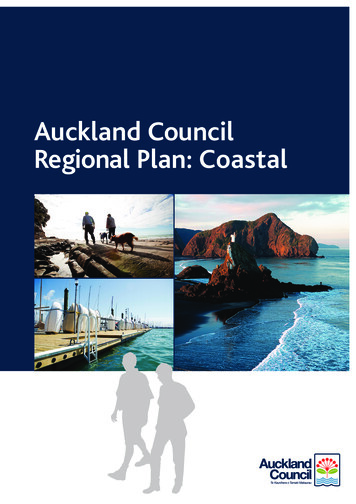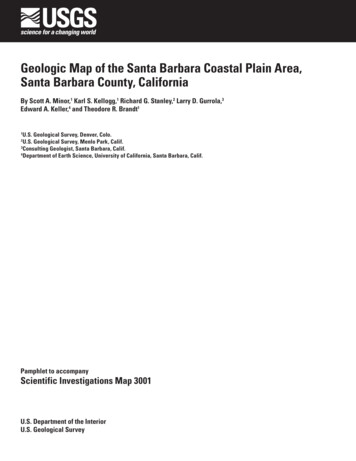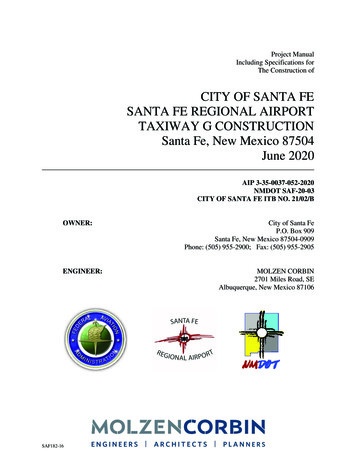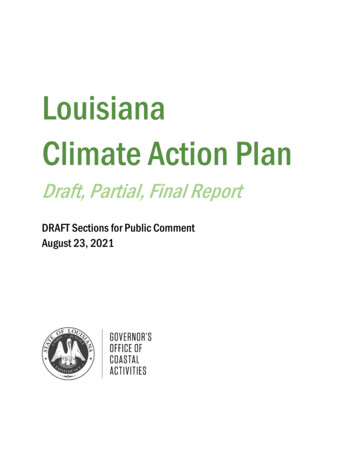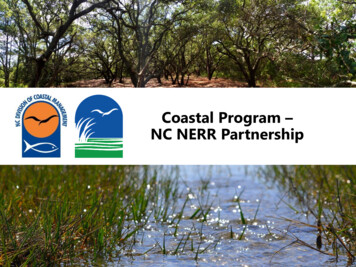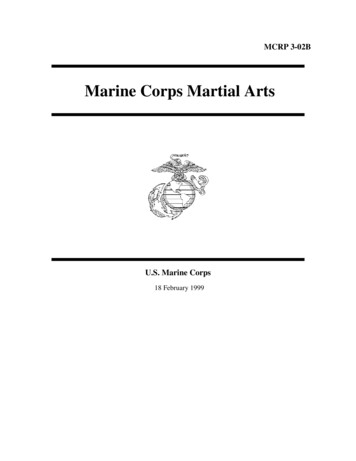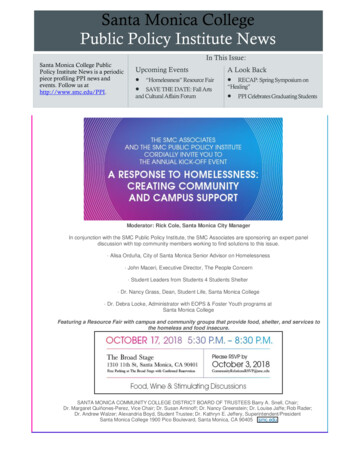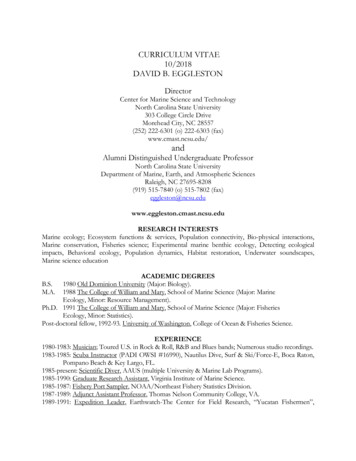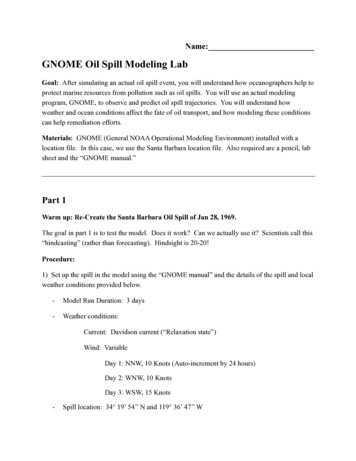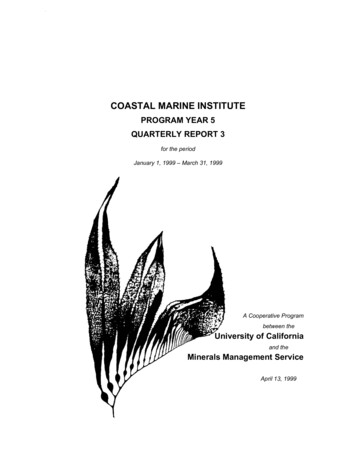
Transcription
COASTAL MARINE INSTITUTEPROGRAM YEAR 5QUARTERLY REPORT 3for the periodJanuary 1, 1999 – March 31, 1999A Cooperative Programbetween theUniversity of Californiaand theMinerals Management ServiceApril 13, 1999
COASTAL MARINE INSTITUTEPROGRAM YEAR 5QUARTERLY REPORT 3for the periodJanuary 1, 1999 – March 31, 1999A Cooperative Programbetween theUniversity of Californiaand theMinerals Management ServiceRussell J. SchmittProgram ManagerCoastal Research CenterMarine Science InstituteUniversity of CaliforniaSanta Barbara, California 93106April 13, 1999
Program Manager's Reportfor the period January 1, 1999 – March 31, 1999This constitutes the quarterly report for the second quarter for Program Year 5 ofthe Coastal Marine Institute, a cooperative research agreement between the MineralsManagement Service, the state of California and the University of California.As of this quarter, 10 projects currently are being conducted under the aegis of theCoastal Marine Institute.Actions Pending MMS Approval: Task 12387: Ecological Consequences of Alternative Abandonment Strategiesfor POCS Offshore Facilities and Implications for Policy Development,requires approval of a no-cost extension; Task 13095: Effects of Produced Water on Complex Behavioral Traits ofInvertebrate Larvae and Algal Zoospores, requires approval of a no-costextension; We are awaiting comments from MMS on the draft final report for Task13293: Aerial Surveys of Marine Birds and Mammals in Santa BarbaraChannel and the Santa Maria Basin.Major Programmatic Progress and Actions during the Quarter: Task 12392: Development of Methods for Surfgrass (Phyllospadix spp.)Restoration Using Early Life History Stages has been completed and the draftfinal study report has been submitted to MMS for review/comments; Task 12391: Effect of Offshore Oil Platform Structures on the DistributionPattern of Commercially Important Benthic Crustaceans, with Emphasis onthe Rock Crab, has been completed and the draft final study report has beensubmitted to MMS for review/comments; Task 13096: Utilization of Sandy Beaches by Shorebirds: Relationships toPopulation Characteristics of Macrofauna Prey Species and BeachMorphodynamics, has been completed and the draft final study report will besubmitted to MMS next quarter.
Task 12387: Ecological Consequences of Alternative Abandonment Strategies forPOCS Offshore Facilities and Implications for Policy DevelopmentPrincipal Investigators: Mark H. Carr, Department of Biology, University ofCalifornia, Santa Cruz, CA 95064, Graham E. Forrester, Dept. of Biology,University of California, Los Angeles, CA 90095-1606, and Michael V.McGinnis, Coastal Research Center and Ocean and Coastal Policy Center,Marine Science Institute, University of California, Santa Barbara, CA 93106Major Accomplishments, January 1, 1999 through March 31, 1999We continued to focus our efforts on processing and analyzing data this past quarter. Theprimary tasks conducted this past quarter were: Continued development of the database, integrating transect volumes with fish countsto estimate fish density by species and size class. Transect volumes are based on thelengths of structural members sampled on platforms. These volumes were used inconjunction with diver and ROV-video recorded fish counts to calculate fishdensities. Species and assemblage level comparisons of recruitment and density (fish per unitwater volume) among platforms and between platforms and reefs were analyzed. Processing of the ROV video tapes to determine fish size distributions (based on lasermethods). Technicians and volunteers (two UCSC undergraduates) located,measured, and recorded fish identification, counts and size estimates from oilplatforms dives and natural reefs. This task is completed. Only size estimates fromdivers on platforms and natural reefs have yet to be completed. A summary of analyses to date was presented at the Platform Ecology and OceanCirculation Symposium, at the 5th California Islands Symposium, Santa Barbara,California, March, 1999.MMS Action Required: Approval of no-cost extension.Future plans: Further analysis and preparation of publications.Estimated Percentage of Budget Expended:Project Year 1 100%Project Year 2 100%Project Year 3 75%
Task 12388: Joint UCSB-MMS Pacific OCS Student Internship and Trainee ProgramPrincipal Investigators: Jenifer Dugan, Coastal Research Center, Marine ScienceInstitute, University California, California. 93106, and Edward A. Keller,Environmental Studies Program, University of California, Santa Barbara,California, 93106Major Accomplishments, January 1, 1999-March 31, 1999During the past quarter, we hired several new student interns in addition to the ongoinginterns. Heather Wallings is working with Mike McCrary, Mark Pierson, Mary ElaineDunaway and Maurice Hill from MMS and Jenny Dugan (UCSB) on a literature reviewof marine mussel ecology and biology. Jorine Lawyer will be working with DavidPanzer on nearshore sediment transport and offshore pipelines. We also advertised andhired 5 student interns, Aurelia Alcantar, Cassandra Hensher, Jorine Lawyer, Peter Paige,and Brandon Thorne, on a temporary basis to assist David Browne (MMS) during theMMS sponsored 5th California Islands Symposium at the end of March. Jenny Dugan isworking with Jim Lima to arrange additional internship opportunities for MMS/CMIprojects during Spring and Summer 1999.Because of scheduling difficulties, no Information Transfer Seminars were presented byCMI/SCEI PI’s this past quarter. Jenny Dugan is working with Jim Lima to determinewhich projects should present talks next quarter and a seminar schedule is beingdeveloped.Future plans:New interns will be hired as needs are identified.Estimated Percentage of Budget Expended:Project Year 1: 100%Project Year 2: 100%Project Year 3: 77%
Task 12390: Testing and Calibrating the Measurement of Nonmarket Values for OilSpills Via the Contingent Valuation MethodPrincipal Investigators: W. Michael Hanemann, Department of Agricultural andResources Economics, University of California, Berkeley, California 94720, andJon A. Krosnick Department of Psychology, The Ohio State University,Columbus, OhioMajor Accomplishments, January 1, 1999 - March 31, 1999We continue our process of collecting survey data through telephone interviews ofrepresentative samples of adults in Ohio. This process yields us 500 interviews permonth and is designed to continue through May, 1999, to yield a total sample size ofapproximately 2,000 respondents. The purpose of this study is to assess any potentialanchoring effects of bid values in willingness-to-pay measurements and to compare opento closed ended WTP measures.We are also continuing design and preparation work to do our final pilot experimentinvolving undergraduate students respondents. This process involves design of aquestionnaire to assess people's beliefs about matters on which they themselves areexperts (e.g., their own personal life histories) and matters on which other people arelikely to be more expert (e.g., technical scientific issues). With this questionnaire, wewill explore whether anchoring effects of bid amounts in contingent valuationmeasurements are greater on issues about which people are not expert than on mattersabout which they are expert.Estimated Percentage of Budget Expended:Project Year 1 92%
Task 13094: Application of Coastal Ocean Dynamics Radars for Observation of NearSurface Currents off the South-Central California CoastPrincipal Investigators: Libe Washburn, Department of Geography, University ofCalifornia, Santa Barbara, CA 93106, Steven D. Gaines, Department of Ecology,Evolution and Marine Biology, University of California, Santa Barbara, CA93106Major Accomplishments, 1 January-31 March, 1999Over the past quarter we have focussed on improving the processing of our highfrequency radar data set. Efficient processing and is essential given the amount of thedata collected each month. Specifically we have upgraded our flow visualizationsoftware so we can incorporate results from our two new sites on Vandenberg Air ForceBase (VAFB). These sites, one at Pt. Arguello and the other just south of Pt. Sal., wereadded in November and December, 1998. We are also developing software to doobjectively map the evolving current flow fields (so-called empirical orthogonal functionanalysis [EOF]).In our last quarterly report we stated that we were going to replace the malfunctioningcomputer and transmit electronics at the new sites with equipment from the closer CoalOil Pt. site. This was successfully accomplished, and we have since repaired themalfunctioning equipment and re-installed it at Coal Oil Point. Apart from occasionalpower outages at Pt. Arguello, all sites have been functioning satisfactorily. However wehave been unable to service our site at Pt. Conception since November (see below)A development since our last report is that our group will be cooperating with a newresearch initiative to study marine recruitment in sub-tidal and inter-tidal habitats. Thisproject is sponsored by the David and Lucille Packard Foundation and involvesinvestigators from Oregon State University, UC Santa Cruz, UC Santa Barbara, andStanford. This will greatly expand the biological studies that have been a part of thisproposal. For example, we have now compiled nearly two years of larval recruitment datafrom 7 sites spanning Pt. Conception. We have obtained biweekly recruitment rates atthese sites for a variety of marine invertebrates. These larval recruitment studies will nowextend all the way to Oregon. Our surface current data will be a key element of thisresearch. At our sites spanning Pt. Conception, we have identified two key transitionregions. The first is between Gaviota and Pt. Conception. The second is near Pt. Sal.There are striking differences in larval species composition in the three regions separatedby these points. With the 5 CODAR antennas now deployed, we can evaluate howcirculation patterns generate the disjunct larval recruitment patterns in these threeregions. We will greatly expand the spatial and temporal resolution of our samp.ing in thenext few months in conjunction with the complementary Parckard Foundation program.We are also working with MMS personnel to maintain at least a subset of theScripps/Center for Coastal Studies array to support this project.Results from our work were presented at two recent meetings: 1) at the High FrequencyRadar Workshop held in San Diego, CA in early March; 2) at the Fifth California IslandsSymposium in Santa Barbara, CA, sponsored by MMS. Our research results were well
received at both meetings. Our MATLAB software for displaying animated current timeseries has been adopted by our colleagues at the Naval Post graduate school in Monterey,California. They presented their data with the “viewer” software we developed at the HFRadar Workshop.Problems Encountered: We are still being denied access to our radar site at Pt.Conception. This has become a very serious problem for us and we need help fromMMS. I have discussed the problem with Dr. Fred Piltz and David Browne, both ofMMS in Camarallo. They exploring ways to correct this situation.MMS Action Required: We need all possible help from MMS in gaining access to ourequipment at Pt. Conception.Estimated Percentage of Budget Expended:Project Year 1: 100%Project Year 2: 100%Project Year 3: 71%
Task 13095: Effects of Produced Water on Complex Behavioral Traits of InvertebrateLarvae and Algal ZoosporesPrincipal Investigator: Peter Raimondi, Department of Biology, University ofCalifornia, Santa Cruz, CA 95064Major Accomplishments, January 1, 1999 through March 31, 1999Summary:As I have previously noted in my reports, the work on the original project stoppedcompletely due to the inability of MMS to supply me with the PW I required.I have forged a collaboration with Dr Gary Cherr from the Bodega Marine Laboratory ofUC, Davis. He has supplied me with other sources of oil-based toxicants to use in ourexperiments. At the moment, I am using some lyophilized PW he had in storage to roundoff my previous PW studies. We are also collaborating on work into the sub-lethaleffects of a bacterial degraded crude oil fraction. It is progressing well.As I have previously stated, I will complete a study, however it will not be the projectMMS originally funded. The MMS-CMI director, Russ Schmit was fully appraised ofthe situation in late 1998.Personnel to March 1999:During this period the Post-Doctoral Researcher, Anthony Boxshall, was the mainresearcher on this grant, however he drew a salary from matching funds. At present, twostudents, Derek Smith and Jason Yonehiro are helping with various aspects of thisproject. Derek is a work study student and Jason is completing 5 academic units ofindependent study.Estimated Percentage of Budget Expended: 95-97%
Task 14181: Population Trends and Trophic Dynamics in Pacific OCS Ecosystems:What Can Monitoring Data Tell Us?Principal Investigators: Russell J. Schmitt, Department of Ecology, Evolution andMarine Biology, University of California, Santa Barbara, CA 93106 and AndrewJ. Brooks, Coastal Research Center, Marine Science Institute, University ofCalifornia, Santa Barbara, CA 93106Major Accomplishments, January 1, 1999 through March 31, 1999Progress to Date:Our MMS-UC CMI funded research encompasses two separate objectives: (1) theanalysis and synthesis of existing long-term monitoring data and (2) the continued annualsurveys of subtidal reef communities at Santa Cruz Island.(1) The analysis and synthesis of existing long-term monitoring data.We have continued with our efforts to obtain additional long-term datasets. All of our1998 Santa Cruz Island data has now been converted into an electronic format. Wecontinue to use this dataset to develop and test our relational database formats. Weanticipated that this process would be the most time consuming and it has proven to beso. We have also begun to convert the raw abundance data contained in these datasetsinto the more ecologically meaningful metrics needed for use in our meta-analyses.(2) The continued annual surveys of subtidal reef communities at Santa Cruz Island.We have completed the sorting and identification of the 1997 resource samples collectedfrom Santa Cruz Island and this data has been entered into the master database. We arenow in the process of sorting and identifying the food resource samples collected duringour 1998 surveys conducted last fall.Publications and Presentations:We are still in the initial stages of compiling and verifying the data which will composeour master database. To date we have no publications.Estimated Percentage of Budget Expended:Project Year 1 12%
Task 15116: Wave Prediction in the Santa Barbara ChannelPrincipal Investigators: Robert T. Guza and William C. O’Reilly, Center for CoastalStudies, Scripps Institution of Oceanography, La Jolla, CA 92093Major Accomplishments, January 1, 1999 through March 31, 1999During the first quarter of the project's second year the reflected wave field from SantaCruz Island has been quantified using existing regional wave data from the Channel. Thelargest amount of reflected energy is found at the far east end of the Channel and isconsistent with strong specular reflection from the coastal cliffs of Santa Cruz Island.However, significant levels of reflected energy have been detected at a number ofhistorical measurement stations north and north-northwest of Santa Cruz Island that arenot along purely reflected propagation paths, indicating that some non-specular wavereflection needs to be incorporated in the model algorithm.A paper on wave prediction in the Santa Barbara Channel and the island reflectionproblem was presented at the 5th California Island Symposium in Santa Barbara onMarch 30.Future Plans:Model north side of Santa Cruz Island as a source of quasi-specular wave reflection.Reflected wave field will be parameterized as a function of the incident wave conditionsat Pt. Conception.Estimated Percentage of Budget Expended:Project Year 1 100%Project Year 2 10%
Task 15117: Assessing Toxic Effects on Population Dynamics Using Individual-BasedEnergy Budget ModelsPrincipal Investigators: Roger M. Nisbet, Department of Ecology, Evolution andMarine Biology, University of California, Santa Barbara, CA 93106 and Erik B.Muller, Marine Science Institute, University of California, Santa Barbara, CA93106Major Accomplishments, January 1, 1999 through March 31, 1999We continued our model analysis in variable food environments, and we are presentlyputting our results in manuscript for publication. As we explained in previous reports,variations in food supply imply that organisms periodically encounter stress, and thisstress adds to other forms, such as the presence of toxic contaminants whose effects wemodeled previously. We assume an environment in which the scaled food density (typeII) fluctuates either periodically or stochastically (pink noise). With both fluctuations, andon the provision of survival, organisms grow more (on average) than their conspecificsgrowing in an average constant food environment, and this increase is a function of theintensity of the fluctuations. The intensity of the fluctuations reduces the (average) lifespan. The life-span is also a function of the model parameter specifying the partitioningof energy between somatic and reproductive tissues, which parameter may varyconsiderably within a species. Individuals are more likely to survive a variable foodenvironment when they reproduce at a relatively high rate. The effects of foodfluctuations on reproduction show a more complex picture. With periodic food, strongfluctuations enhance reproduction in organisms that favor reproduction over growth, butreduce reproduction in organisms that give higher priority to growth. With stochasticfood, reproduction in surviving individuals increases with the intensity of the foodfluctuations, but the reproductive effort of a cohort may decline. The production andsurvival potential of an individual in a variable food environment thus depends on thetype and strength of the food fluctuations, and on the priority status it gives toreproduction.Future Plans:As in proposal.Estimated Percentage of Budget Expended:Project Year 1 38%
Task 15118: An Experimental Evaluation of Methods of Surfgrass (Phyllospadixtorreyi) Restoration Using Early Life History StagesPrincipal Investigators: Daniel C. Reed, Marine Science Institute, University ofCalifornia, Santa Barbara, CA 93106 and Sally J. Holbrook, Department ofEcology, Evolution and Marine Biology, University of California, Santa Barbara,CA 93106Major Accomplishments, January 1, 1999 through March 31, 1999During this quarter of research we continued our monthly sampling of flower abundanceand flowering state at a subset of our permanent sites (five intertidal sites and onesubtidal site). We also continued our monthly sampling of seed availability at these sitesusing artificial seed collectors. All data collected to date have been entered into our database and stored on a PC. Data entry and quality control continue to be an ongoing task.We completed our semiannual sampling of our nine intertidal permanent sites. Becauseof adverse ocean conditions we only sampled one of our permanent subtidal sites(Mohawk) during this survey. At each site we measured the densities of floweringshoots, vegetative shoots, and seedlings, and the percentage cover of surfgrass, algae,bare rock and sand.We began testing several different methods for outplanting laboratory-reared seedlings tothe field. Experiments are now underway to test the effects of seedling density (threelevels), algal cover (two levels) and outplant technique (three levels) on seedlingsurvivorship and growth in both intertidal and subtidal habitats. To date over fivethousand seedlings have been outplanted to the field. In addition, we have monitored thesurvivorship and growth of 25 naturally recruited seedlings at one intertidal site (MoreMesa) monthly since November 1998. Data on sand inundation is also recorded on eachvisit. Lastly, we also conducted laboratory experiments using seeds collected from thefield to examine the ability of host algae and artificial seed collectors to retain seeds andseedlings under varying conditions of flow.PIs Reed and Holbrook spent much time this quarter analyzing data for inclusion into twomanuscripts, which are currently in preparation. One paper focuses on temporal patternsof seed predation at four sites during the period 1995-1998, while the second paperexamines patterns of flowering, seed abundance and seedling recruitment (and therelationships among them) at nine intertidal and five subtidal sites during the period1995-1998. A another paper on the effects of algal morphology and flow on seedlingattachment was accepted for publication in Marine Ecology Progress Series.Future Plans: Work will proceed as scheduled.Estimated Percentage of Budget Expended:Project Year 1 89%
Environmental Studies Program, University of California, Santa Barbara, California, 93106 Major Accomplishments, January 1, 1999-March 31, 1999 During the past quarter, we hired several new student interns in addition to the ongoing interns. Heather Wallings is working with Mike McCrary, Mark Pierson, Mary Elaine
